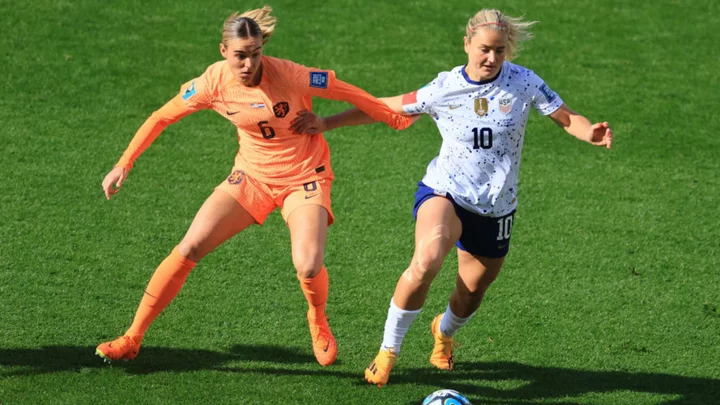The United States had to come from behind against Netherlands to avoid defeat in a Women's World Cup game (excluding penalties) for the first time since the 2011 group stage.
Lindsey Horan's second half header cancelled out a first half strike from Dutch midfielder Jill Roord in what was a repeat of the 2019 final, and 1-1 was how it finished in Group E.
With both teams on four points from two games, things are delicated balanced ahead of the final round of group fixtures when the United States face Portugal and Netherlands meet Vietnam.
1. Dutch patience rewarded
The Dutch team showed patience in the early stages of the match, absorbing pressure from tournament favorites and responding to the waves of attack by calmy retaining the ball and forcing their opponents into turnovers.
When the Americans didn't have the ball, which was 61% of the time in the first half, they were disjointed defensively, and the Dutch approach paid off when Roord found herself unmarked in the 17th minute, calmly slotting the ball past goalkeeper Alyssa Naeher for the opening goal.
The early lead allowed the Netherlands to adopt a defensive stance, frustrating the Americans' attempts to break through their well-organized line.
2. USWNT have the ability to overcome adversity
Although the USWNT doesn't often face adversity on the pitch, often blowing past teams, they demonstrated their resilience against here.
Lindsey Horan's pivotal header from Rose Lavelle's corner kick the momentum in their favour. The team truly displayed ab ability to dig deep even when not at their best, a crucial trait, especially with many players experiencing their first World Cup.
Moments prior to the goal, Horan got into it with Lyon teammate Danielle van de Donk after the latter committed a hard tackle. The referee was forced to get involved after some shoving and words were exchanged.
"That's where you get the best football from Lindsey," Horan said after the match. "I don't think you ever want to get me mad because I don't react in a good way. Usually I just go and I want something more. I want to win more, I want to score more, I want to do more for my team.
"So that moment, that little tackle - big tackle - changed a shift in my head because I want to do everything for my team and to win these games."
3. Ertz, the unheralded hero
Julie Ertz certainly isn't the flashiest player but she plays such a vital role as a defensive presence in the backline.
Even playing out of position, she was constantly winning important duels, making tackles, and showcasing her leadership in the absence of captain Becky Sauerbrunn, who isn't at the tournament due to a foot injury. Her defensive contributions, including a crucial block to deny the Netherlands a goal, proves her versatility and effectiveness in different positions.
Her leadership also shines through, as she was the one attempting to calm Horan, who had already been booked in the Vietnam match, down after she got into the exchange with Van de Donk.
"Julie came up to me in the box and she was like, 'Linds, please, don't get another yellow card. Just score this goal to shut everyone up.' And that's what happened," said Horan.
4. Lavelle's impact despite fitness concerns
Rose Lavelle made a notable difference when she came on at half-time. The midfielder would usually be a undisputed starter, but her minutes are being managed as she comes back from injury. Her dynamic style injected a lot of pace into the midfield, lifting the tempo for the US.
The team will need her to be at her best as the tournament continues and her fitness remains a concern. She needs to be fit enough to start matches to maintain her impact throughout the game as the USWNT face more difficult opposition.
5. Questionable tactics from Andonovski
Despite the point, Vlatko Andonovski failed to adapt to the Dutch team's predictable setup, leaving his team struggling to keep up. The lineup he chose, the exact same one used against Vietnam, proved that there was no plan in place to stifle the Netherlands' weaknesess.
Additionally, using only one substitution, despite having one of the deepest squads at the tournament, was questionable. Not utilising more options from the bench indicated a willingness to settle for a draw, which was unnecessary and unambitious given the team's capabilities.
Players like Trinity Rodman and Sophia Smith, who have talent but lack experience and showed signs of franticness, needed to be substituted off.
Andonovski's comments after the match signified that he felt that the US were in control of the match, and that substitutions weren't needed, also seem strange given that the Dutch were well on top in the first half but pinned back late in the second. The US would have strongly benefited from fresh faces against the tired legs of the Netherlands.
"I thought we had control of the game and we were knocking on the door of scoring a goal," Andonovski said.
"Our players played well. We were around the goal the whole time, and I just didn't want to disrupt the rhythm at that point because sometimes a substitute comes in and it might take a minute or two to get into a rhythm.
"We just didn't want to jeopardise anything because I thought all three of our forwards were very good today, dangerous, created opportunities and were a handful."
Andonovski was asked specifically if winger Lynn Williams was considered as an option off the bench, he said: "Yes, we of course talked about substitutes and Lynn was probably one of the first that would've been on the field of we needed to change something."
READ MORE ON THE WOMEN'S WORLD CUP IN AUSTRALIA & NEW ZEALAND
This article was originally published on 90min as Women's World Cup: Five things we learned from USA 1-1 Netherlands.

